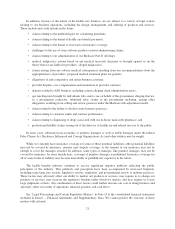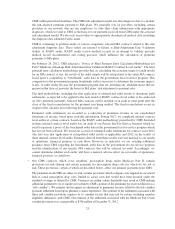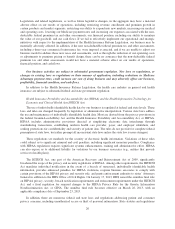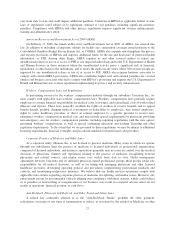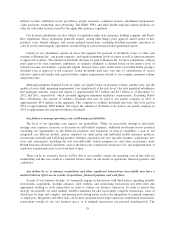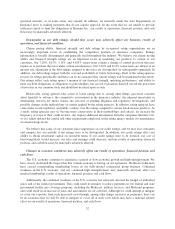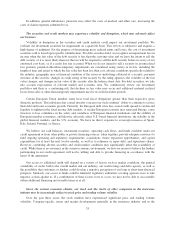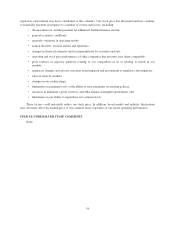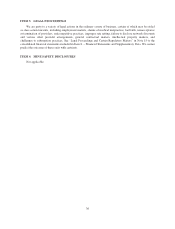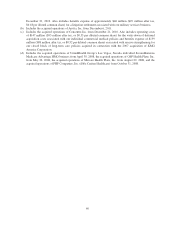Humana 2012 Annual Report Download - page 41
Download and view the complete annual report
Please find page 41 of the 2012 Humana annual report below. You can navigate through the pages in the report by either clicking on the pages listed below, or by using the keyword search tool below to find specific information within the annual report.addition, the FDA inspects facilities in connection with procedures to effect recalls of prescription drugs. The
Federal Trade Commission also has requirements for mail-order sellers of goods. The U.S. Postal Service, or
USPS, has statutory authority to restrict the transmission of drugs and medicines through the mail to a degree that
may have an adverse effect on our mail-order operations. The USPS historically has exercised this statutory
authority only with respect to controlled substances. If the USPS restricts our ability to deliver drugs through the
mail, alternative means of delivery are available to us. However, alternative means of delivery could be
significantly more expensive. The Department of Transportation has regulatory authority to impose restrictions
on drugs inserted in the stream of commerce. These regulations generally do not apply to the USPS and its
operations. In addition, we are subject to CMS rules regarding the administration of our PDP plans and
intercompany pricing between our PDP plans and our pharmacy business.
We are also subject to risks inherent in the packaging and distribution of pharmaceuticals and other health
care products, and the application of state laws related to the operation of internet and mail-order pharmacies.
The failure to adhere to these laws and regulations may expose us to civil and criminal penalties.
Changes in the prescription drug industry pricing benchmarks may adversely affect our financial
performance.
Contracts in the prescription drug industry generally use certain published benchmarks to establish pricing
for prescription drugs. These benchmarks include average wholesale price, which is referred to as “AWP,”
average selling price, which is referred to as “ASP,” and wholesale acquisition cost. Recent events have raised
uncertainties as to whether payors, pharmacy providers, pharmacy benefit managers, or PBMs, and others in the
prescription drug industry will continue to utilize AWP as it has previously been calculated, or whether other
pricing benchmarks will be adopted for establishing prices within the industry. Legislation may lead to changes
in the pricing for Medicare and Medicaid programs. Regulators have conducted investigations into the use of
AWP for federal program payment, and whether the use of AWP has inflated drug expenditures by the Medicare
and Medicaid programs. Federal and state proposals have sought to change the basis for calculating payment of
certain drugs by the Medicare and Medicaid programs. Adoption of ASP in lieu of AWP as the measure for
determining payment by Medicare or Medicaid programs for the drugs sold in our mail-order pharmacy business
may reduce the revenues and gross margins of this business which may result in a material adverse effect on our
results of operations, financial position, and cash flows.
If we do not continue to earn and retain purchase discounts and volume rebates from pharmaceutical
manufacturers at current levels, our gross margins may decline.
We have contractual relationships with pharmaceutical manufacturers or wholesalers that provide us with
purchase discounts and volume rebates on certain prescription drugs dispensed through our mail-order and
specialty pharmacies. These discounts and volume rebates are generally passed on to clients in the form of
steeper price discounts. Changes in existing federal or state laws or regulations or in their interpretation by courts
and agencies or the adoption of new laws or regulations relating to patent term extensions, and purchase discount
and volume rebate arrangements with pharmaceutical manufacturers, may reduce the discounts or volume rebates
we receive and materially adversely impact our results of operations, financial position, and cash flows.
Our ability to obtain funds from our subsidiaries is restricted.
Because we operate as a holding company, we are dependent upon dividends and administrative expense
reimbursements from our subsidiaries to fund the obligations of Humana Inc., our parent company. These
subsidiaries generally are regulated by states’ Departments of Insurance. We are also required by law to maintain
specific prescribed minimum amounts of capital in these subsidiaries. The levels of capitalization required
depend primarily upon the volume of premium generated. A significant increase in premium volume will require
additional capitalization from our parent company. In most states, we are required to seek prior approval by these
state regulatory authorities before we transfer money or pay dividends from these subsidiaries that exceed
31


